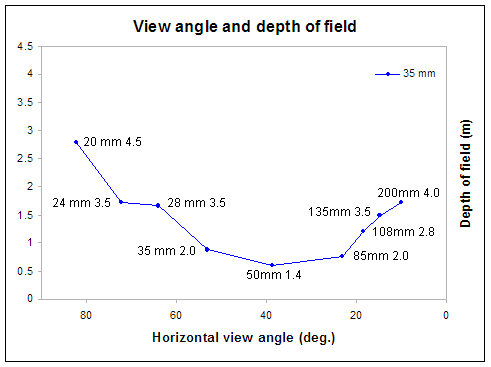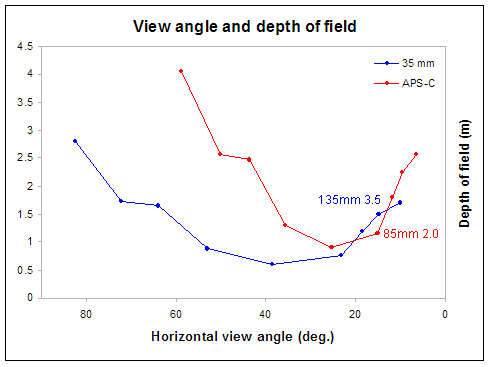Depth-of-field considerations when choosing between a full-frame and reduced-frame digital SLR
Introduction
Main considerations when comparing full-frame and reduced frame digital SLRs typically lie in the areas of price, image quality and view-angle.
One often neglected area comparison is the depth-of-field that each camera would give.
The comparison here would be based on APS-C and 35mm, and the basis of comparison will be prime lenses of commonly available focal lengths and apertures.
The prime lenses used are as follows:
20 mm f/4.5
24 mm f/3.5
28 mm f/3.5
35 mm f/2.0
50 mm f/1.4
85 mm f/1.8
108 mm f/2.8
135 mm f/3.5
200 mm f/4.0
Comparison methodology
After visualising a scene, a photographer must select the appropriate focal length to cover the correct view angle. This focal length is dependent of the sensor size used. The focal length on a full frame camera is 1.6 times that of a APS-C camera to result in the same view.
For example, a 50mm lens on an APS-C camera will give the same view angle as an 80mm lens on a full frame camera.
Using idealised equations (which are suitable for use with prime lenses due to their reasonably simple optical design), the depth of field can be calculated when the sensor size, focal length, aperture, and subject distance is known.
In this simulated study, the following is assumed:
The photographer wants to capture an object 3m wide on camera. After putting on a lens, the photographer moves himself to a position so that the 3m object fills the frame. He then selects the largest aperture, and then observes the depth of field after taking the photograph.
The following correlation is used:

Using this correlation for a full frame camera and 50mm f/1.4 lens, we adjust the subject distance to 4.3 m so that the 3m wide subject fills the frame. We then determine the depth of field (in this case it is 0.6 m). A 50mm lens on a full frame camera spans a horizontal view angle of 39°.
The result can be charted on a graph, where we compare view angle with depth of field.

Figure 1. The depth of field of various lenses when mounted to a 35mm camera, with aperture wide open and the subject distance adjusted such that a 3m wide object fills the frame.
The same exercise is repeated for the APS-C camera, and the data is plotted on the same chart for comparison.
We see that the view angle for the lenses are narrower, which is not surprising since the APS-C sensor is smaller and thus sees a narrower field. A correlation between the view angles of full frame and reduced-frame cameras is as follows:
When mounted on a reduced frame camera, the view angle is the same as a lens 1.6 times longer mounted on a full frame camera. For example, the view of a 50mm lens on an APS-C camera is equivalent to that of a 80mm lens on a full frame camera.

Figure 2. The depth of field of various lenses when mounted to a 35mm camera and an APS-C camera, with aperture set to wide open and the subject distance adjusted such that a 3m wide object fills the frame.
More importantly, the depth of field becomes wider when using a reduced frame camera. This is the case through the entire range of lenses, except at 85mm, where an 85mm lens on a reduced frame will out-bokeh a 135 mm lens on a full frame camera. Incidentally, the view from these two set-ups are equivalent. A 85mm on APS-C looks like a 136mm on full frame (85 x 1.6 = 136).
Conclusion
Depth of field at any specific view angle is dependent on both the view angle and aperture size. Using a system of inter-changeable lenses on both full frame and reduced frame cameras, the full frame camera consistently results in a narrower depth of field, aiding the application of bokeh.
Main considerations when comparing full-frame and reduced frame digital SLRs typically lie in the areas of price, image quality and view-angle.
One often neglected area comparison is the depth-of-field that each camera would give.
The comparison here would be based on APS-C and 35mm, and the basis of comparison will be prime lenses of commonly available focal lengths and apertures.
The prime lenses used are as follows:
20 mm f/4.5
24 mm f/3.5
28 mm f/3.5
35 mm f/2.0
50 mm f/1.4
85 mm f/1.8
108 mm f/2.8
135 mm f/3.5
200 mm f/4.0
Comparison methodology
After visualising a scene, a photographer must select the appropriate focal length to cover the correct view angle. This focal length is dependent of the sensor size used. The focal length on a full frame camera is 1.6 times that of a APS-C camera to result in the same view.
For example, a 50mm lens on an APS-C camera will give the same view angle as an 80mm lens on a full frame camera.
Using idealised equations (which are suitable for use with prime lenses due to their reasonably simple optical design), the depth of field can be calculated when the sensor size, focal length, aperture, and subject distance is known.
In this simulated study, the following is assumed:
The photographer wants to capture an object 3m wide on camera. After putting on a lens, the photographer moves himself to a position so that the 3m object fills the frame. He then selects the largest aperture, and then observes the depth of field after taking the photograph.
The following correlation is used:

Using this correlation for a full frame camera and 50mm f/1.4 lens, we adjust the subject distance to 4.3 m so that the 3m wide subject fills the frame. We then determine the depth of field (in this case it is 0.6 m). A 50mm lens on a full frame camera spans a horizontal view angle of 39°.
The result can be charted on a graph, where we compare view angle with depth of field.

Figure 1. The depth of field of various lenses when mounted to a 35mm camera, with aperture wide open and the subject distance adjusted such that a 3m wide object fills the frame.
The same exercise is repeated for the APS-C camera, and the data is plotted on the same chart for comparison.
We see that the view angle for the lenses are narrower, which is not surprising since the APS-C sensor is smaller and thus sees a narrower field. A correlation between the view angles of full frame and reduced-frame cameras is as follows:
When mounted on a reduced frame camera, the view angle is the same as a lens 1.6 times longer mounted on a full frame camera. For example, the view of a 50mm lens on an APS-C camera is equivalent to that of a 80mm lens on a full frame camera.

Figure 2. The depth of field of various lenses when mounted to a 35mm camera and an APS-C camera, with aperture set to wide open and the subject distance adjusted such that a 3m wide object fills the frame.
More importantly, the depth of field becomes wider when using a reduced frame camera. This is the case through the entire range of lenses, except at 85mm, where an 85mm lens on a reduced frame will out-bokeh a 135 mm lens on a full frame camera. Incidentally, the view from these two set-ups are equivalent. A 85mm on APS-C looks like a 136mm on full frame (85 x 1.6 = 136).
Conclusion
Depth of field at any specific view angle is dependent on both the view angle and aperture size. Using a system of inter-changeable lenses on both full frame and reduced frame cameras, the full frame camera consistently results in a narrower depth of field, aiding the application of bokeh.
Labels: applied mathematics, photographic equipment, photography

<< Home